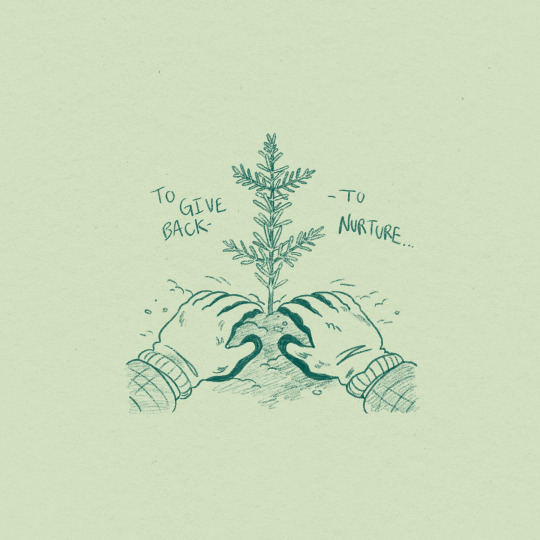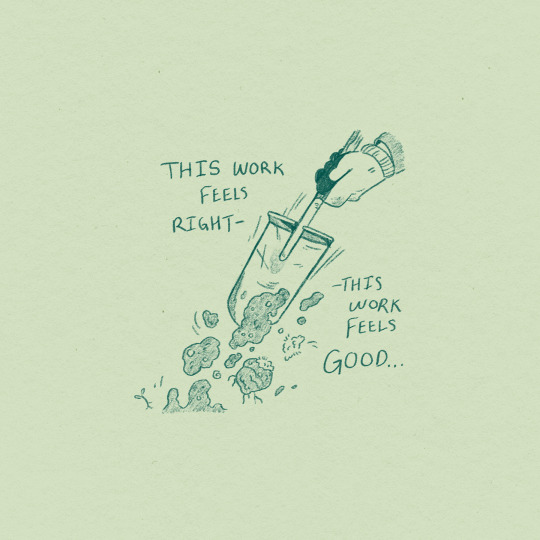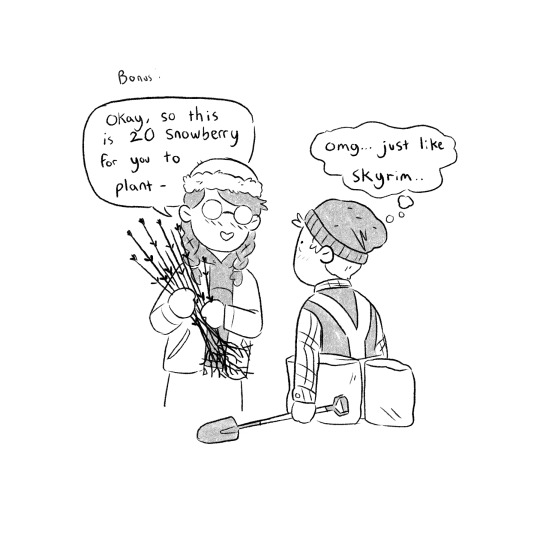#restore nature
Explore tagged Tumblr posts
Text

Pachama
#Pachama#restore nature#remove carbon#technology#climate change#protect#life on earth#green#typography#type#typeface#font#Matter#Matter Mono#Chromatic Pro Condensed#2024#Week 12#website#web design#inspire#inspiration#happywebdesign
2 notes
·
View notes
Text
A caveat to this study: the researchers were primarily looking at insect pollinator biodiversity. Planting a few native wildflowers in your garden will not suddenly cause unusual megafauna from the surrounding hinterlands to crowd onto your porch.
That being said, this study backs up Douglas Tallamy's optimistic vision of Homegrown National Park, which calls for people in communities of all sizes to dedicate some of their yard (or porch or balcony) to native plants. This creates a patchwork of microhabitats that can support more mobile insect life and other small beings, which is particularly crucial in areas where habitat fragmentation is severe. This patchwork can create migration corridors, at least for smaller, very mobile species, between larger areas of habitat that were previously cut off from each other.
It may not seem like much to have a few pots of native flowers on your tiny little balcony compared to someone who can rewild acres of land, but it makes more of a difference than you may realize. You may just be creating a place where a pollinating insect flying by can get some nectar, or lay her eggs. Moreover, by planting native species you're showing your neighbors these plants can be just as beautiful as non-native ornamentals, and they may follow suit.
In a time when habitat loss is the single biggest cause of species endangerment and extinction, every bit of native habitat restored makes a difference.
#nature#wildlife#animals#ecology#environment#conservation#science#scicomm#pollinators#bees#butterflies#hoverflies#insects#native plants#habitat restoration#solarpunk#hopepunk#naturecore#wildflowers#good news
6K notes
·
View notes
Text

PEOPLE THIS IS NOT A DRILL BEAVERS ARE GOING TO BE FREELY RELEASED INTO THE WILD IN THE UK THIS IS HUGE!!!
It is such, such a big deal. The difference this will make for biodiversity, for carbon sequestration, for protecting us from flooding, for nature connection. People have been fighting so hard for so long to bring our beaver neighbours home and free them from the fences they’ve been kept behind. Not ashamed to admit I’ve cried a bit today after hearing this news. This is a wonderful step to make us just a bit wilder, a bit more ecologically intact, a bit more free. Moments like this remind me that progres seems unthinkable until it happens, and then it feels inevitable. I can’t wait for the first release - and shoutout to the illegal beaver bombers who got them a foothold when red tape was holding people back.
Lynx next!!!!
#solarpunk#social justice#hopepunk#environmentalism#cottagepunk#optimism#community#bright future#climate justice#rewilding#nature restoration#beaver reintroduction#Eurasian beaver#hope#joy#rare Britain W
1K notes
·
View notes
Text



"Our findings emphasize the power of predators as ecosystem architects," said William Ripple. "The restoration of wolves and other large predators has transformed parts of Yellowstone, benefiting not only willows but other woody species such as aspen, alder, and berry-producing shrubs. It's a compelling reminder of how predators, prey, and plants are interconnected in nature." Wolves were eradicated and cougars driven to low numbers from Yellowstone National Park by the 1920s. Browsing by elk soon increased, severely damaging the park's woody vegetation, especially in riparian areas. Similar effects were seen in places like Olympic National Park in Washington, and Banff and Jasper National Parks in Canada after wolves were lost. While it's well understood that removing predators can harm ecosystems, less is known about how strongly woody plants and ecosystems recover when predators are restored. Yellowstone offers a rare opportunity to study this effect since few studies worldwide have quantified how much plant life rebounds after large carnivores are restored.
#good news#environmentalism#science#environment#nature#animals#yellowstone#wolves#yellowstone wolves#usa#national parks#yellowstone national park#trophic cascade#restoration#regeneration#revitalization#large carnivores
907 notes
·
View notes
Text
Dandelion News - February 15-21
Like these weekly compilations? Tip me at $kaybarr1735 or check out my Dandelion Doodles!
1. Solar farms managed for nature boost bird abundance and diversity, new study finds

“There were more than twice as many farmland birds in the well-managed solar farms compared with the intensively farmed land, and nearly 16 times as many woodland birds. […] Overall, diversity was 2.5 times higher, while woodland birds were nine times more diverse.”
2. Washington judge blocks Trump’s gender-affirming care ban, says it's unconstitutional in multiple ways

“This marks the second time in a week that a judge has stood in the way of Trump’s attacks on trans kids. [… The ruling grants] a temporary restraining order that halts enforcement of provisions in Trump’s directive that would cut off federal funding to medical institutions that provide gender-affirming care to minors.”
3. Fog harvesting could provide water for arid cities

“17,000 sq m of mesh could produce enough water to meet the weekly water demand of [… the] urban slums. 110 sq m could meet the annual demand for the irrigation of the city's green spaces. Fog water could be used for soil-free (hydroponic) agriculture, with yields of 33 to 44lb (15 to 20kg) of green vegetables in a month.”
4. Audubon Applauds Bipartisan Federal Effort to Protect Delaware River Basin with Critical Reauthorization Bill

“The bill would […] ensure long-term conservation and restoration efforts, expand the official definition of the basin to include Maryland, and prioritize projects that serve small, rural, and disadvantaged communities. […] The watershed provides important year-round habitats and critical migratory stopovers for approximately 400 bird species[….]”
5. mRNA vaccines show promise in pancreatic cancer in early trial
“Half of the people in the study — eight of the participants — responded to the vaccine, producing T cells that targeted their tumors. […] Just two of the patients who had a response to the vaccine had their cancer return during the three-year follow- up, compared to seven of the eight who did not respond to the vaccine treatments.”
6. Minn. Lt. Gov. Flanagan Makes It Official; She's running for U.S. Senate

“[Flanagan has] “championed kitchen-table issues like raising the minimum wage, paid family and medical leave, and free school meals.” If elected, Flanagan, a tribal citizen of the White Earth Nation, would become the first Native American female U.S. senator in history.”
7. Federal Funding Restored for Low-Income Alabama Utility Assistance After Outcry

“A program meant to help low-income Alabamians pay their utility bills has resumed two weeks after it was canceled due to an executive order from President Donald Trump. […] “We can confirm the funds are reaching those affected by the previous pause[….]””
8. Modeling study suggests Amazon rainforest is more resilient than assumed

“[Previous] studies were either conducted with global climate models that used a simplified representation of convection [or were on a regional scale….] According to the computations, mean annual precipitation in the Amazon does not change significantly even after complete deforestation.“
9. States are moving forward with Buy Clean policies despite Trump reversal

““Buy Clean is a great example of how states and other nonfederal actors can continue to press forward on climate action, regardless of what the federal government does,” said Casey Katims, executive director of the U.S. Climate Alliance, a bipartisan coalition of two dozen governors.”
10. The rewilded golf courses teeming with life

“A wildflower meadow, ponds, scrub habitat, coastline and even an area of peat bog can be found on this little 60-acre (24-hectare) plot, which boasts roe deer, otters, lizards, eels and a huge array of insects and birds.”
February 8-14 news here | (all credit for images and written material can be found at the source linked; I don’t claim credit for anything but curating.)
#hopepunk#good news#nature#us politics#solar power#solar panels#solar energy#birds#biodiversity#gender affirming care#transgender#trans rights#trans healthcare#water conservation#habitat#migratory birds#vaccines#vaccination#mrna vaccine#pancreatic cancer#cancer#native american#alabama#low income#amazon rainforest#rainforest#executive orders#climate action#golf course#habitat restoration
990 notes
·
View notes
Text
From the article:
The new law aims to restore at least 20% of the EU's land and seas, with specific targets including reversing the decline of pollinators and restoring 25,000 kilometres of rivers to free-flowing conditions. This target is instrumental to align EU policy with global commitments made by almost 200 countries to restore and protect at least 30% of our planet’s degraded ecosystems by 2030. The legislation solidifies Europe's leadership in global biodiversity restoration and protection efforts, setting a powerful example for the rest of the world.
This law is in many ways the first of its kind and creates legally binding restoration targets for various ecosystems throughout the EU.
#nature restoration#EU#politics#good news#habitat#habitat restoration#ecosystem#ecosystem restoration#ecosystem conservation#conservation#habitat conservation#hope#hopepunk#climate change#environment#endangered species#biodiversity
939 notes
·
View notes
Text
Moon Pearl
hwat if BP finally reformed after years of grief and took her mum's place as the new embodiment of the Almighty Sea~?





But, be wise to not mistake this change of mind as passive. For she is as beautiful as she is volatile, sailors of all stripes being cautioned to offer tribute to the sea for the promise of a safe voyage.
#Black Pearl Cookie#I am so unnormal about her-#Moon Pearl Cookie#Idk I've seen other artists taking a crack at a reformed pearl design and wanted in on the action#This was one of the things I lost in the outage that I was proud of...#So naturally I wanted to restore that shit the fastest#Yes I interpret her and Sea Fairy's relationship as mother and daughter#no hate if you ship SeaPearl I guess but that ain't me chief#cookie run kingdom#cookie run#CRK
4K notes
·
View notes
Text
"To mark the birth of their first child, Sienna, in 2018, Kevin and Kelly Williams planted a tangerine tree in their Lahaina yard. When their second child Malia arrived in 2020, they added a lime tree.
But the trees never had a chance to bear fruit before the Aug. 8, 2023 wildfire destroyed them, along with the Williams family’s home, their property management business and most of the town.
Now, on their new property in Ukumehame about 15 minutes south of Lahaina, the family is growing a much bigger bounty — about 220 trees, all native species, that one day will return to the backyards of families like theirs.
“Absolutely amazing to be able to think one day we can drive through Lahaina and see the trees that we helped raise,” Kevin Williams said.
Over the past year and a half, a sprawling network of volunteers, local farmers, nurseries and hotels have stepped up to host thousands of young trees growing in pots that will be replanted in Lahaina through the Treecovery Hawai‘i project.
Since launching in November 2023, the initiative has bloomed into 6,200 trees being cared for at 25 grow hubs, with about 160 already replanted at the handful of homes that have been rebuilt in Lahaina and Kula. While displaced families focus on returning to their homes, the volunteers are making sure the trees and the soil are nurtured and ready to shade and feed the community for years to come.
“It really does a lot to people’s minds and hearts when they see growth and they see that rebirth of the land,” said Duane Sparkman, founder and president of Treecovery and chair of the Maui County Arborist Committee. “Restoring the ‘āina from the soil up is what we have to do.”
THE ROOTS
When 59-year-old Ekolu Lindsey talks to relatives from his dad’s generation about Lahaina, the smell of mangos comes to mind. Everyone had their favorite fruit trees in Lahaina, and oftentimes they were the ones in their own yards, said Lindsey, who lost his Front Street home in the fire.
“All those stories, it’s the memories of home. It’s all part of who we are as people,” said Lindsey, a Treecovery board member and head of Maui Cultural Lands, a nonprofit that works to protect and restore Hawaiian resources across the island.
Lahaina was historically home to a canopy of fruit trees, including breadfruit, which gave rise to the name Malu ‘Ulu o Lele, “the shaded breadfruit grove of Lele.” They helped create a cooler climate, capture rainwater and mitigate soil erosion, independent researcher Adam Keawe Manalo-Camp wrote in the Office of Hawaiian Affairs’ “Ka Wai Ola” publication. The removal of breadfruit trees and diversion of streams to pave the way for sugar cane production in the mid-1800s dried up the once productive landscape and opened the door for invasive species.
The 2023 fire again razed the trees of Lahaina — about 21,000, according to Treecovery’s estimates — and burned so hot that it likely killed microbes in the soil as deep as 18 inches underground, Sparkman said. In Kula and Lahaina, federal workers scraped 6 inches of soil off the top of each property and tested it for contaminants before people were allowed to rebuild.
Struck by how barren the land was, Sparkman and his team launched Treecovery with the goal of growing 30,000 trees to replace what Lahaina lost. Lindsey sits on the board along with Matthew Murasko, Rodger May and cultural adviser Archie Kalepa.
The idea was to establish grow hubs where trees could be nurtured until residents were ready to plant. The Royal Lahaina Resort, where Sparkman is the chief engineer, served as a staging site before the very first grow hub opened with 125 fruit tree saplings at the Marriott’s Maui Ocean Club in April 2024.
The network grew to nearly every corner of the island, from the Kā‘anapali Beach Resort to the Fairmont Kea Lani to the Kahului Airport and independent growers in East Maui. It’s a labor of love where the on-site workers or volunteers water, weed and transfer the plants to larger pots as they grow.
Treecovery takes requests for trees on their website, buys them from local nurseries and transports them to the grow hubs where they are cared for and labeled with the names of the families they will be donated to, according to Murasko, an entrepreneur, product designer and brand builder who met Sparkman while volunteering in Honokōwai Valley 17 years ago. Murasko said they’ve raised about $600,000 and that they pay full price for the trees and pots to help support local businesses. The trees cost about $100 each but can get as expensive as $2,000 for a 65-gallon mango tree or $3,000 to move and install a large palm tree, Sparkman said.
There are a variety of trees, including native species like koai‘a and ‘a‘ali‘i; fruit trees like Mapulehu mango, dwarf avocado, peach and citrus; and flowering trees such as plumeria and puakenikeni...
Sparkman, a longtime landscaper and former scientific biological technician at Haleakalā National Park who has been honored for his organic landscaping practices, said Treecovery wants to return the natural system of healthy microbes into the soil.
The steady recovery of the iconic 150-year-old banyan tree is proof that it can work. Sparkman said it’s grown “leaps and bounds” more than they expected with the help of 500 gallons of microbial life, rich with fungi and bacteria that trees need and pests can’t survive in.
“It takes years for nature to put it back, but man can help it by pulling these indigenous microbes and moving it for nature,” he said.""
-via Maui Now, April 28, 2025
#maui#hawaiʻi#hawaii#wildfire#natural disaster#lahaina#united states#trees#rewilding#ecosystem restoration#disaster recovery#native plants#good news#hope
475 notes
·
View notes
Text



Small journal about my new job, plus a silly little bonus

#my art#artists on tumblr#illustration#lgbt artists#nature art#comics#conservation#habitat restoration#journal
2K notes
·
View notes
Text

so cool
#drawing hasnt felt too natural lately so i drew an echo to restore my soul#feels good to just fling colors on a canvas#echo#bugbot#robot
165 notes
·
View notes
Text


HYUNJIN for WKOREA & VERSACE
#hyunjin#skz#stray kids#bystay#staydaily#*edits#if u crack my skull open like a coconut. u will find these pics spinning there like the ballerinas in music boxes#seeing him versace and i was like ah the balance of nature and life has been restored 🩷#in versace*
652 notes
·
View notes
Text

If there is magic on this planet, it is contained in water
- LOREN EISELEY
#water view#water art#water conservation#water everywhere#water energy#water element#water is life#water magic#water nymph#toya's tales#style#toyastales#toyas tales#art#july#summer#red and blue#red carpet#area rug#handmade rug#carpets and rugs#persian rugs#water quality#water reflection#water resources#water restoration#water ripples#water rights#water tribe#nature
329 notes
·
View notes
Note
I made some drawings of vasco and machete on ibis paint so I hope you don't mind, since I don't really see art of natural machete I decided to draw him.

.
#tiny little Machetes and Vascos#;-;#they look so expressive#I love Machete's big vaguely trepidated mantis eyes#do you want your catholic dog natural trimmed or fully smoothed#I should draw him with his natural fur/hair? more often#getting my hp restored by Vasco's smiles#as always#thank you!#gift art#gemeral-dragob3rt#own characters#Machete#Vasco
343 notes
·
View notes
Text
by Grant Brown, Wed 16 Jul 2025
A unique high school program empowers students to play a vital role in California salmon conservation efforts.
In an era when most teenagers are glued to their phones, Casa Grande High School students wade through cold creeks to save endangered fish. Their unusual after-school program strengthens California salmon conservation efforts while making waves in the scientific community.
The United Anglers program at Casa Grande High School in Sonoma County represents a new model for California salmon conservation. In 2023, these teenage conservationists tracked 33 salmon in local waterways, providing vital data to federal wildlife officials. Each fish represents a small victory in the ongoing battle to protect Northern California’s aquatic ecosystems.
These are not just casual observations. The students hold an official state permit to catch, tag, and release salmon. They record the location, size, and health condition of each fish—information that strengthens California salmon conservation by filling crucial gaps in scientific knowledge about the Petaluma watershed. This data helps shape conservation policies and wildlife management strategies.
Climate change and urban development pose growing threats to local fish populations. As rivers warm and change course, salmon struggle to find their way back to their breeding grounds. The students’ work helps scientists understand how these changes affect fish migration patterns. Their findings could influence future urban planning and environmental protection measures.

What started as a club for habitat cleanup and tree planting 42 years ago has evolved into a sophisticated conservation program. Today’s students handle complex responsibilities and contribute meaningful data to federal research efforts. Their work exemplifies the potential of youth-led environmental initiatives.
The students’ newest challenge focuses on steelhead trout, a threatened species that is becoming increasingly rare in local waters. After years of preparation, the program received federal permission to rescue and shelter juvenile steelhead from drying rivers—a significant achievement for a high school program. This new permit allows students to remove fish from threatened areas and care for them until conditions improve.
Daily responsibilities keep these young conservationists busy. They feed fish, clean massive tanks, monitor water temperatures, and transport heavy equipment for fieldwork. Many students find an unexpected passion in this hands-on conservation work, and the program often sparks lifelong interest in environmental protection.
The program’s success stems partly from the students’ fearless approach to fieldwork. They scramble up muddy riverbanks and wade through icy waters with enthusiasm. This practical experience prepares them for future environmental science and conservation biology careers.
Dan Hubacker, the science teacher overseeing the program, emphasizes its importance for steelhead trout conservation. He said adult steelhead have not been seen near the school in years. The students’ work could help prevent this species from disappearing from local waterways.
The program also creates strong bonds among participants. Students report finding their place in school through this shared mission. As they care for juvenile fish struggling to survive, these teenagers gain perspective on their journey to adulthood. Many form lasting friendships through their shared commitment to conservation.
Darren Howe, San Francisco Bay branch supervisor of NOAA Fisheries, praises the students’ contributions. Their ongoing data collection helps fill gaps in understanding fish populations, providing vital information for conservation decisions. This collaboration between students and federal agencies sets a promising example for future conservation efforts.
The success of United Anglers demonstrates the untapped potential of engaging young people in scientific research and environmental protection. These students collect valuable data while developing real-world skills in field research, data analysis, and wildlife management.
The program’s impact reaches beyond immediate conservation goals. It shows how environmental education can transform students into active champions of California salmon conservation. As climate change threatens more species, programs like United Anglers become increasingly crucial for protecting vulnerable wildlife.
The United Anglers program shows how young people can contribute to wildlife conservation. From its humble beginnings as a creek cleanup project, it has evolved into a model for hands-on environmental education. Their success has inspired similar initiatives across California, advancing salmon conservation through youth engagement and citizen science.
#good news#environmentalism#science#environment#nature#animals#conservation#climate change#climate crisis#usa#california#salmon#fish#salmon restoration#rivers#salmon conservation#wildlife#citizen science#youth
443 notes
·
View notes